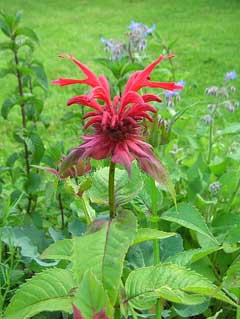
Bergamot, Scarlet beebalm, Horsemint, Oswego Tea, Bee Balm
Latin Name: Monarda didyma
USDA Hardiness: 4-10
Native Range: NORTHERN AMERICA: United States, Connecticut, Maine, Massachusetts, New Hampshire, New Jersey, New York, Ohio, Pennsylvania, Vermont, West Virginia, Georgia (north), Kentucky (northeast), North Carolina (west), Tennessee, Virginia,
Edibility Rating: 3 / 5
Medicinal Rating: 2 / 5
Region:
Family:
Plant Type:
Medicinal Uses
Edible Uses
Edible Parts: Flowers Leaves Shoots | Edible Uses: Condiment TeaLeaves and young shoot tips - raw or cooked. They are used as a flavouring in salads, fruit salads, drinks etc[46, 61, 105, 183]. Flowers - raw. They are added as an attractive garnish to salads[183, 238, 244]. An excellent aromatic tea is made from the fresh or dried leaves and flower heads[21, 46, 105, 183]. The leaves give an Earl Grey flavour to China tea[238].
Cultivation
Easily grown in ordinary garden soil so long as it is not too dry[1, 200]. Grows well in heavy clay soils. Requires a moist soil and a sunny position[4, 200]. Prefers some shade[4] but succeeds in a sunny position so long as the soil does not dry out. Provide light shade in hotter zones. Plants are hardy to at least -25°c[187]. The flowers are rich in nectar and are very attractive to bees[4, 55, 244]. A good companion plant, it grows well with tomatoes[14, 20]. Bergamot is a very ornamental and aromatic plant, it is often grown in the herb garden, there are some named varieties[183, 233]. The leaves, stems and roots carry a delicious aromatic orange-like perfume when crushed[245]. Plants are subject to mildew in dry summers[200]. Special Features: The plant is heat tolerant in zones 10 through 1. (Plant Hardiness Zones show how well plants withstand cold winter temperatures. Plant Heat Zones show when plants would start suffering from the heat. The Plant Heat Zone map is based on the number of "heat days" experienced in a given area where the temperature climbs to over 86 degrees F (30°C). At this temperature, many plants begin to suffer physiological damage. Heat Zones range from 1 (no heat days) to 12 (210 or more heat days). For example Heat Zone. 11-1 indicates that the plant is heat tolerant in zones 11 through 1.) For polyculture design as well as the above-ground architecture (form - tree, shrub etc. and size shown above) information on the habit and root pattern is also useful and given here if available. The plant growth habit is a runner spreading indefinitely by rhizomes or stolons [1-2]. The root pattern is rhizomatous with underground stems sending roots and shoots along their length [1-2].
Known Hazards
None known
Habitats
Moist soils[235] in rich woods, thickets and bottom lands[43].
